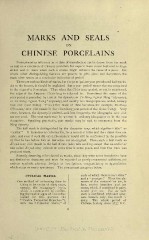Page 519 - Oriental Series Japan and China, Brinkly
P. 519
MARKS AND SEALS
ON
CHINESE PORCELAINS
No trustworthy inference as to date of manufacture can be drawn from the mark
or seal on a specimen of Chinese porcelain, for experts have never hesitated to forge
either seal or mark when such a course might enhance the value of a piece. But
where other distinguishing features are present in pdte, glaze, and decoration, the
mark often serves as a conclusive indication of period.
There are various kinds of marks, but the principal are year periods and hall marks.
As to the former, it should be explained that a year period means the era comprised
in the reign of a Sovereign. Thus, when the Chien-lung period, or era, is mentioned,
the reign of the Emperor Chien-lung is referred to. Sometimes the name of the
year period is preceded by that of the dynasty, as Ta-Ming, " great "
Ming (dynasty),
or Ta-Tsing, "great Tsing " (dynasty), and usually two ideographs are added, namely
nien chih (year make). Thus a full mark of date becomes, for example, Ta-Tsing
Chien-lung nien chih (made in the Chien-lung year-period of the Great Tsing). Very
often, however, the dynasty is omitted, and, less frequently, the ideographs nien chih
are not used. The year mark may be written in ordinary ideographs or in the seal
characters. Speaking practically, year marks may be said to commence from the
Ming dynasty.
The hall mark is distinguished by the character tang, which signifies " kiln " or
" atelier." It furnishes no information, for a record of kilns and their dates does not
exist, and even if such did exist, the student would still be confronted by the possibil-
ity that he has before him an imitation, not an original. Thus, such a hall mark as
Ki-yuh-tang chih (made in the hall of rare jade) tells nothing except that an atelier or
kiln called Ki-yuh-tang existed at some time in some place, and that fine ware was
produced there.
Scarcely deserving to be classed as marks, since they were never intended to have
any distinctive character and must be regarded as purely ornamental additions, are
various symbols, pictorial designs or inscriptions, congratulatory or appreciative,
which occur on many specimens. The commonest are given below.
CYCLICAL MARKS. each of which there is an " elder "
and a " younger." Thus the ele-
One method of reckoning time in ments of the composition are, in
China is by cycles of sixty years, fact, twelve branches and ten
namely, the sexagenary cycle, stems, which, if combined in pairs,
which is constructed by combin- would give 120. But as each
ing the twelve signs of the zodiac stem is combined with each alter-
(called for this purpose the
" Twelve Terrestrial Branches "), nate branch only, the result is
with five " Celestial Stems," of
sixty. The whole period of
Chinese history since 2637 B.C.

